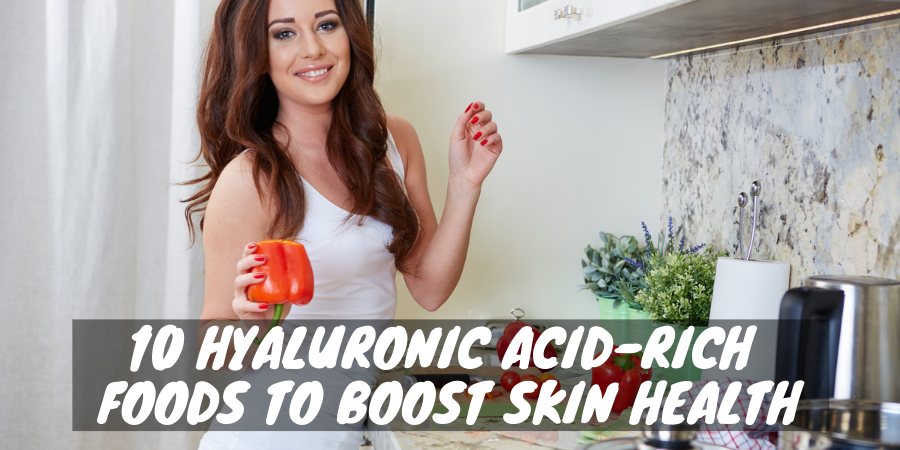Hyaluronic acid is one of the most hyped skincare ingredients out there. It’s the go-to solution for dry, dehydrated, aging skin.
But you don’t have to buy creams, serums and moisturizers to enjoy its benefits.
Many foods contain high levels of hyaluronic acid, and it has great effects on your skin whether you apply it topically or eat it.
Try these 10 foods to boost your hyaluronic acid levels in the tastiest possible way.
Why Is Hyaluronic Acid Important?
As a humectant, hyaluronic acid performs a vital role in your skin’s health: keeping it hydrated.
Dehydrated skin ages faster and is less able to heal itself from damage. But when you supply it with hyaluronic acid, a miraculous transformation occurs.
Hyaluronic acid binds to water molecules and transports them through the various layers of your skin. This allows your dehydrated skin cells to quench their thirst and get back to operating at full capacity.
Why Should I Eat Hyaluronic Acid Foods?

Your body naturally produces its own hyaluronic acid, and there’s usually plenty of it to go around in your early years.
But as you age, hyaluronic acid production decreases. That’s why one of the signs of aging is dry, dehydrated skin — it no longer has enough hyaluronic acid to maintain appropriate water levels.
You can supplement your hyaluronic acid by using skincare products that contain it. But unless you slather yourself head-to-toe in them, only some of your skin will reap the benefits.
By eating foods that contain hyaluronic acid, your entire body gets a boost of this amazing acid. And as a bonus, most hyaluronic acid-rich foods also contain high levels of the vitamins and minerals your skin needs to stay healthy.
10 Foods That Are High in Hyaluronic Acid
Kale and Other Dark, Leafy Greens
We’ve been told to eat more greens since we were children, and for good reason.
Dark, leafy greens are packed with fiber and plant protein, smoothing out our digestion and supplying us with our day-to-day energy.
But they’re also high in magnesium — a key component of hyaluronic acid production.
Spinach, romaine lettuce, and kale are the most common dark, leafy greens, but you can also try microgreens, arugula, collard greens, and bok choy. Enjoy them in a salad, a smoothie, or a sandwich, and see how your skin responds!
Potatoes and Sweet Potatoes
Root vegetables like potatoes and sweet potatoes are staples of the modern diet.
And that’s good news for our skin: they’re rich in many nutrients that promote hyaluronic acid production.
Loaded with magnesium, potassium and fiber, starchy root vegetables provide plenty of fuel for your skin. And that’s not all: they’re full of collagen-boosting vitamins like vitamin A, vitamin C and vitamin B6.
Carrots

They’re not just good for your eyes! Carrots also provide many benefits for your skin, including increased hyaluronic acid.
Thanks to their high vitamin content, carrots have a rejuvenating effect on the skin. Not only will the extra dose of hyaluronic acid rehydrate your parched skin, the vitamins found in carrots will brighten your complexion and slow down the aging process.
Flax Seed
The flax plant is the source of linen cloth, but its uses don’t stop at textiles.
Flax seed is becoming well-known as a superfood for its versatility and numerous health benefits. And it’s on its way to becoming a staple in the skincare world, too.
It’s high in omega-3 fatty acids, which many people are deficient in. Your body needs omega-3 fatty acids to produce collagen, elastin and — you guessed it — hyaluronic acid.
And it’s easy to incorporate flax seed into your diet. Ground it up and blend it into your morning smoothie, sprinkle it on cereal, add it to condiments like mustard or even use it as an egg replacer in baked goods.
Walnuts and Other Tree Nuts
Walnuts, almonds and other tree nuts are a fantastic way to get more protein and healthy fats.
But few people know that they’re also excellent sources of hyaluronic acid.
The high omega-3 fatty acid content of nuts amps up your body’s hyaluronic acid production. It also provides a handy boost to collagen and elastin production, making for a triple threat against the many signs of aging.
Bone Broth
Bone broth is all the rage in the health food world right now. And it’s about to be all the rage in the skincare world as well.
Bones are surprisingly rich in nutrients, especially protein, potassium and essential fatty acids. All of these are essential for your body to produce hyaluronic acid.
By simply simmering bones for at least 24 hours, you can extract these nutrients into an easily-consumable broth. The broth can then be drank as-is or turned into a delicious soup — either way, it’s amazing for your skin.
Oranges and Other Citrus Fruits

Few foods can turn dehydrated skin into supple, glowing, healthy skin as quickly as citrus fruits.
They’re loaded with vitamin C, which is as essential for slowing the process of aging as it is for staving off scurvy.
But grapefruit, oranges, lemons and citrus fruits contain another secret weapon: a compound called naringenin that stops your body from breaking down hyaluronic acid.
This means that if you eat citrus fruits, your natural hyaluronic acid supply will last longer, as will any hyaluronic acid you absorb through topicals or other foods.
Green and Black Olives
Put them on your pizza, add some to your sub or just pop them as a snack — however you eat olives, your skin will thank you.
Olives are high in essential fatty acids and antioxidants, both of which are vital for skin health. They’re also rich in vitamin E, which boosts cell function and, subsequently, your hyaluronic acid production.
Soy-Based Foods
When your estrogen levels increase, so does your natural hyaluronic acid production.
That makes soy-based foods excellent for those who want fuller, healthier skin.
Eating soy-based foods like tofu, tempeh, edamame and soy milk won’t impact your estrogen levels in a noticeable or harmful way. But on a cellular level, they’ll kickstart your body’s hyaluronic acid production, which is great news for your skin.
Red Meats
Worry not, meat lovers: you can get your hyaluronic acid from your diet without giving up your beef!
Red meat, especially organ meat, is a great dietary source of hyaluronic acid. That’s because, like us, animals also naturally produce hyaluronic acid, storing it primarily in their skin and organs.
If organ meat doesn’t sound appetizing, you can still get hyaluronic acid from regular old beef, pork, and lamb meat. But if you’re an adventurous eater, you’ll find high concentrations of it in a liver, eyeballs, and even chicken combs.

